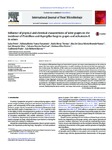Use este identificador para citar ou linkar para este item:
http://www.alice.cnptia.embrapa.br/alice/handle/doc/1059865Registro completo de metadados
| Campo DC | Valor | Idioma |
|---|---|---|
| dc.contributor.author | FREIRE, L. | pt_BR |
| dc.contributor.author | PASSAMANI, F. R. F. | pt_BR |
| dc.contributor.author | THOMAS, A. B. | pt_BR |
| dc.contributor.author | NASSUR, R. de C. M. R. | pt_BR |
| dc.contributor.author | SILVA, L. M. | pt_BR |
| dc.contributor.author | PASCHOAL, F. N. | pt_BR |
| dc.contributor.author | PEREIRA, G. E. | pt_BR |
| dc.contributor.author | PRADO, G. | pt_BR |
| dc.contributor.author | BATISTA, L. R. | pt_BR |
| dc.date.accessioned | 2017-01-04T11:11:11Z | pt_BR |
| dc.date.available | 2017-01-04T11:11:11Z | pt_BR |
| dc.date.created | 2017-01-04 | pt_BR |
| dc.date.issued | 2016 | pt_BR |
| dc.identifier.citation | International Journal of Food Microbiology, v. 241, p. 181-190, 2016. | pt_BR |
| dc.identifier.uri | http://www.alice.cnptia.embrapa.br/alice/handle/doc/1059865 | pt_BR |
| dc.description | The incidence of filamentous fungi and toxin levels in grapes and wines varies depending on the variety of grapes, the wine region, agricultural practices, weather conditions, the harvest and the winemaking process. In this sense, the objective of this study was to evaluate the diversity of Aspergillus and Penicillium fungi isolated fromwine grapes of the semi-arid tropical region of Brazil, evaluate the presence of ochratoxin A (OTA) in the experimental wine and verify if there is a correlation between occurrence of these fungi and the physicochemical characteristics of the wine grapes grown in the region. For the isolation of fungi we used the direct plating technique. The presence of OTA in the experimental wine was detected by high-performance liquid chromatography. The species found were Aspergillus niger, A. carbonarius, A. aculeatus, A. niger Aggregate, A. flavus, A. sojae, Penicillium sclerotiorum, P. citrinum, P. glabrum, P. decumbens, P. solitum and P. implicatum. All isolates of A. carbonarius were OTA producers and all P. citrinum were citrinin producers. The highest concentration of OTA was found in red wine (0.29 ?g/L). All species identified in this study, except A. flavus, showed a positive correlation with at least one physicochemical parameter assessed, highlighting the pectin content, total sugar, total acidity and phenolic compounds. | pt_BR |
| dc.language.iso | eng | pt_BR |
| dc.rights | openAccess | eng |
| dc.subject | Fungo filamentoso | pt_BR |
| dc.subject | Fungo isolado | pt_BR |
| dc.title | Influence of physical and chemical characteristics of wine grapes on the incidence of Penicillium and Aspergillus fungi in grapes and ochratoxin A in wines | pt_BR |
| dc.type | Artigo de periódico | pt_BR |
| dc.date.updated | 2019-05-06T11:11:11Z | pt_BR |
| dc.subject.thesagro | Uva | pt_BR |
| dc.subject.thesagro | Doenca de planta | pt_BR |
| dc.subject.thesagro | Vinho | pt_BR |
| dc.subject.thesagro | Fungo | pt_BR |
| riaa.ainfo.id | 1059865 | pt_BR |
| riaa.ainfo.lastupdate | 2019-05-06 -03:00:00 | pt_BR |
| dc.contributor.institution | Luísa Freire, Federal University of Lavras, Lavras, Brazil; Fabiana Reinis Franca Passamani, Federal University of Lavras, Lavras, Brazil; Ariela Betsy Thomas, Federal University of Lavras, Lavras, Brazil; Rita de Cássia Mirela Resende Nassur, Empresa Brasileira de Pesquisa Agropecuária/EMBRAPA, Semiárido, Petrolina, PE, Brazil; Lais Mesquita Silva, Federal University of Lavras, Lavras, Brazil; Fabiano Narciso Paschoal, Fundação Ezequiel Dias, Belo Horizonte, MG, Brazil; GIULIANO ELIAS PEREIRA, CNPUV; Guilherme Prado, Fundação Ezequiel Dias, Belo Horizonte, MG, Brazil; Luís Roberto Batista, Federal University of Lavras, Lavras, Brazil. | pt_BR |
| Aparece nas coleções: | Artigo em periódico indexado (CNPUV)  | |
Arquivos associados a este item:
| Arquivo | Descrição | Tamanho | Formato | |
|---|---|---|---|---|
| 1s2.0S0168160516305645main.pdf | 501,39 kB | Adobe PDF |  Visualizar/Abrir |









